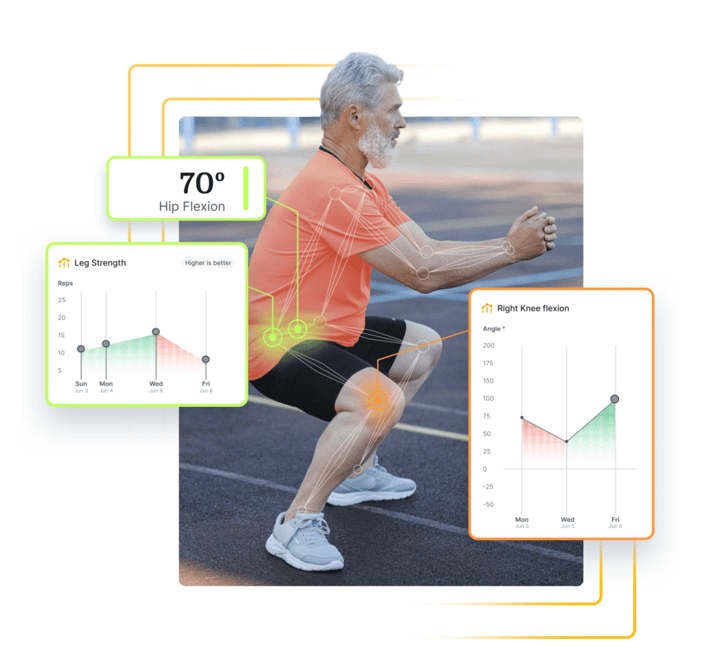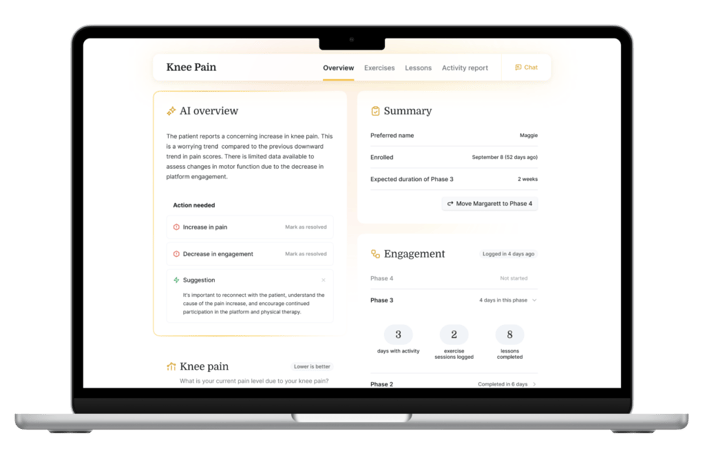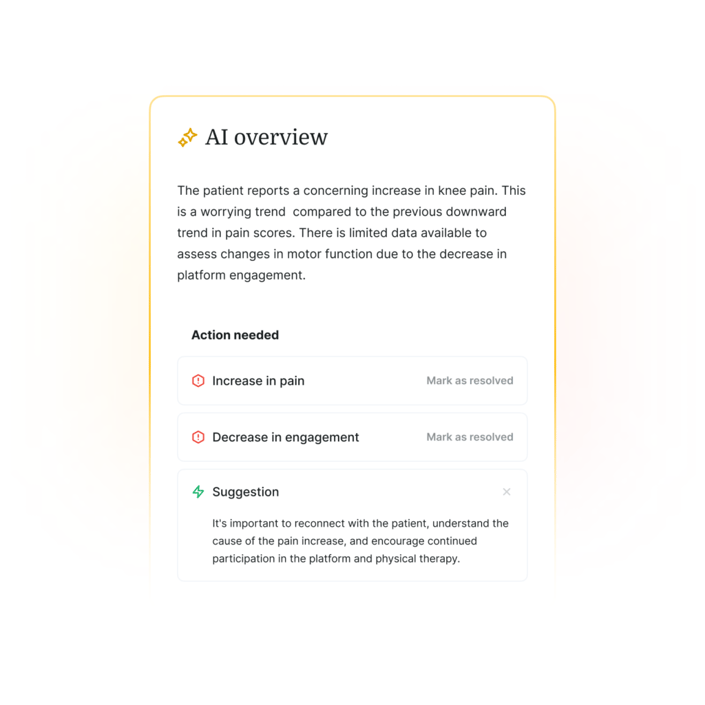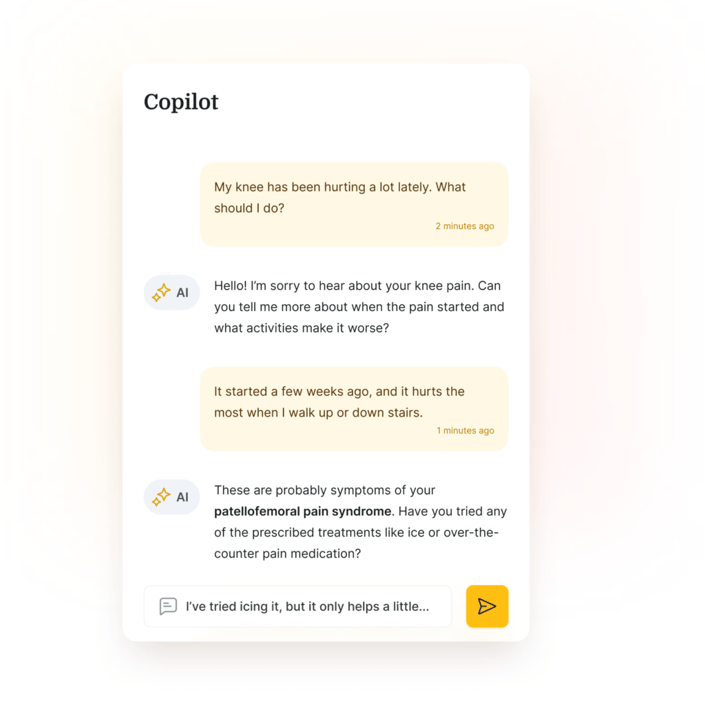From Motion Capture to Patient Copilots: How AI is Expanding What's Possible in Digital MSK Care
June 20, 2024
7 min. read

2024 has unquestionably been the year of artificial intelligence. The speed at which AI companies are innovating is mind-blowing, and one of the most common questions I get asked by customers is How is Medbridge innovating with AI? It's a big question that could change the course of the future of healthcare. That's why when we decided to incorporate AI at Medbridge, we knew that we had to do it right.
When we think about AI, we tend to think about Large Language Models (LLMs): how to build the models with data, how to gather data, and how to render data. But there are tens of thousands of ways to incorporate AI in a given product or solution. When you break down the best way to apply AI to a solution, it's not really about incorporating AI for its own sake; it's about how AI can support the user to accomplish the things they need to do.
Our user is the clinician. Over 300,000 clinicians use Medbridge today, and we know the idea of building any product these clinicians use means we're fighting for their time. These products need to create incredible value—and fast. No clinician wakes up thinking, How do I use AI today? But they do wake up and think, How am I going to get all of my documentation done today and still have time to give my undivided attention to my patients?
AI in our space needs to help the clinician do their job faster, more efficiently, and perhaps even better. AI is only useful when it's incorporated in a way to make our end users lives easier.
So how is Medbridge innovating with AI?
I'm excited to share a few different ways Medbridge is incorporating the use of artificial intelligence into our new digital MSK product, Pathways. When we began building Pathways, we knew it had to be valuable first and foremost for clinicians because if our experience in serving them for over a decade has taught us anything, it's that their time is valuable.
Over 50 million home exercise programs have been prescribed to Medbridge patients over the last decade, which has given us a wealth of experience in understanding how both clinicians and patients approach treatment. Our experience has given us direct insight into the problem areas that slow down clinician workflows and decrease patient engagement. From this, we can take our historical learnings and use cutting edge AI toolsets to solve long term problems.
Motion Capture
One of the most fascinating innovations in physical therapy over the last few years is the use of motion capture technology to support providers in their analysis of patients' functional movement and range of motion.
Motion capture can be used to digitally observe movement, gait, exercise technique, and more to give therapy clinicians an extra set of data to assist assessment. We've integrated this functionality into Pathways to help streamline self-guided, hybrid, and in-clinic programs. In a self-guided pathway, for example, we help the patient progress through different phases of independent exercise and education programs. Within each program and phase, the patient can test their range of motion through a collection of pre-configured functional movement protocols aimed at quantifying movement ability.

What's truly remarkable is that all of this can now be accomplished with the patient's mobile device, without any additional expensive hardware required. The exercise motion is tracked, and AI technology builds a bio-mechanical dataset for analysis. Complex movements are broken into critical checkpoints, and actionable insights are provided both for the patient and the clinician.
The progress that computer vision has enabled is groundbreaking on its own, but predictive AI can take it a step further and provide additional value for the clinician. By collecting and synthesizing all of this data, we can use AI to augment the existing workflow and enable clinicians to keep tabs on their patients by understanding how they are progressing in their physical therapy journey. Patients can improve their functional movement and range of motion at home with the oversight of a clinician, and they can see meaningful, measured progress. This helps clinicians manage low-acuity patients virtually, but still allows them to monitor and guide their patient's progress. And this in turn frees up clinicians to treat more higher-acuity patients in person and spend their time on more complex cases, while also keeping tabs on how their lower-acuity patients are progressing.
AI Patient Summaries
Between patients' range of motion and functional movement data to how they are progressing through their care pathway, there is a lot of information available to the clinician through Pathways. While we love data at Medbridge, the last thing a busy clinician needs is to be handed a dense spreadsheet to parse through.
That's where AI Patient Summaries can help.


Our AI-created summaries help clinicians see exactly what's going on with the patient with one click of a button. Using AI in this manner, we can save the clinician time by pulling together information from across the patient lifecycle into a single easy-to-digest paragraph, and relevant information can be hyperlinked up for clinician review and verification. Patients, in turn, benefit from the customization that clinicians can add to programs with the extra time saved in data review.
Patient Copilot
My personal favorite new functionality is our AI chatbot that we are releasing later this year. Our Patient Copilot operates similarly to other AI chatbots—patients are able to type in a question or a prompt, and they will receive responses generated by artificial intelligence and developed from our incredibly robust library of education and exercises, all backed by clinical experts.

We have curated an incredibly deep experience with a host of exercises and education available to patients. When patients progress through their care pathway program in a series of phases, each incorporates specific exercises and education.
But our Pathways application also allows patients to engage in other ways, such as logging rest days or testing their form for a specific movement using computer vision technology. One of the reasons we built functionality that allows patients to engage with the app outside of their assigned program is because we understand that patient engagement is the name of the game. The more patients engage, the higher the chances they progress through their program and improve their pain and function.
With Patient Copilot, patients can ask their AI chatbot anything, including:
What exercises are included in my fall prevention program?
How should I expect to feel after completing my program?
How many times per week do I need to do this exercise?
How common is low back pain?
Allowing them to search through this information outside of their typical pathway program is something we believe will be very important to keep them engaged. Keeping more patients engaged and enrolled will allow clinicians to see their patients satisfied, staying with them throughout their therapy journey, and most important of all, improving.
This is just a sneak peek at the ways in which Medbridge is innovating with AI in our new Pathways product, and we're hard at work behind the scenes to use this amazing technology to streamline processes for providers and enrich the patient experience. Stay tuned when I'll be sharing more exciting updates in the coming months.
Learn more about Pathways and watch our overview video here, or request a demo with our sales team to see Pathways in action.
Disclaimer: Please note, some of the material discussed is in the early stages of exploration and development. The timelines and functionalities mentioned are subject to change and may not be delivered as currently anticipated. Medbridge makes no guarantees regarding the final implementation or availability of the discussed technologies and features. For the most current and accurate information, please refer to our official communications or contact our sales team directly.





